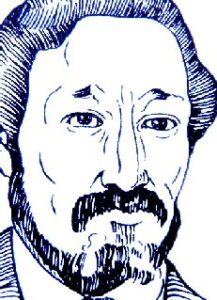Villamil y Ballivián. La primera narrativa arqueológica boliviana (1872) en perspectiva
Llull, 2022, vol. 45, nº 91
Villamil and Ballivian. The first bolivian archaeological narrative (1872) in perspective
Juan Villanueva Criales

Cómo citar
Villanueva Criales, Juan (2022). «Villamil y Ballivián. La primera narrativa arqueológica boliviana (1872) en perspectiva». Llull, 45(91), 89-113.<https://doi.org/10.47101/llull.2022.45.91.villanueva>
¡Comparte en tus redes!
Resumen
Este texto recorre la vida y obra de Emeterio Villamil de Rada y de Vicente Ballivián y Roxas. Ambos emitieron, cerca de 1872, una tesis hiperautoctonista acerca del pasado prehispánico boliviano, postulando al sitio de Tiwanaku y al idioma aymara como origen de la humanidad.
Se desarrollan los antecedentes del pensamiento colonial e ilustrado respecto a Tiwanaku y al origen de los americanos; se recogen los antecedentes biográficos de ambos autores, pertenecientes a familias y bandos políticos rivales durante la segunda mitad del siglo XIX, y se analizan los puntos resaltantes de la narrativa hiperautoctonista frente a las ideas precedentes. Posteriormente se pondera el impacto que tuvieron ambos autores sobre la intelectualidad boliviana de finales del siglo XIX, y la importancia de esta narrativa como un ingreso a la sociedad boliviana en dicho contexto histórico, marcado por la guerra del Pacífico.
Finalmente, se postula a esta narrativa hiperautoctonista como la primera producida por autores locales, en una tensión entre una admiración por la Europa moderna y un patriotismo originado en las guerras de independencia y consolidación de la nación boliviana. Así, se reivindica el lugar de Villamil y Ballivián en una secuencia histórica del pensamiento arqueológico boliviano.
Abstract
This paper reviews the life and work of Emeterio Villamil de Rada and Vicente Ballivián y Roxas, who issued, around 1872, a hyper-autochthonist thesis about the Bolivian Pre-Hispanic past, positing the site of Tiwanaku and the Aymara language as starting points for humanity.
The paper summarizes the antecedents of colonial and enlightened thought regarding Tiwanaku and the origin of the first Americans; it reveals the biographical background of both authors, belonging to rival families and political factions during the second half of the 19th century; and it recognizes the highlights of the hyper-autochthonist narrative compared to previous ideas. Then, the paper ponders the impact that both authors had on the late-nineteenth-century Bolivian intellectual life, and the importance of this narrative as an entry into the Bolivian society of that historical moment, marked by the Pacific War.
Finally, the hyper-autochthonist narrative is posited as the first one produced by local authors, amid a tension between an admiration for modern Europe and patriotism, originated in the wars of independence and consolidation of the Bolivian nation. The paper concludes by claiming a place for Villamil and Ballivián in a historical sequence of Bolivian archaeological thought.
Palabras clave
Arqueología, filología, siglo XIX, Bolivia.
Keywords
Archaeology, Philology, 19th century, Bolivia.

